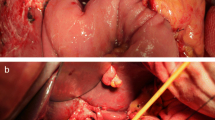Abstract.
Pancreatoduodenectomy has become safer, but postoperative complications, including life-threatening intraperitoneal bleeding, are still relatively common. We recently treated intraperitoneal bleeding after pancreatoduodenectomy by performing a laparotomy in conjunction with the use of a large occlusion balloon catheter. Angiography had failed to identify the site of bleeding in this patient. Our experience suggests that using a large occlusion balloon catheter to control bleeding effectively maintains an adequate surgical field in patients requiring laparotomy for hemostasis.
Similar content being viewed by others
Author information
Authors and Affiliations
Additional information
Received: March 14, 2002 / Accepted: September 3, 2002
Reprint requests to: I. Hoshino
Rights and permissions
About this article
Cite this article
Hoshino, I., Yamamoto, H., Tasaki, K. et al. Use of an Occlusion Balloon Catheter During Laparotomy for Control of Postoperative Bleeding After Pancreatoduodenectomy. Surg Today 33, 240–242 (2003). https://doi.org/10.1007/s005950300054
Issue Date:
DOI: https://doi.org/10.1007/s005950300054




